
You’d think such a world might be a hot one, but you’d be wrong. Later, astronomers would identify more than 400 active volcanoes there, making Io the most geologically active world in our solar system.

Team leader Brad Smith said this made Io look like a pizza. The mission team would find half a dozen more erupting volcanoes on Io over the course of the mission. An active volcano was spotted on the innermost of the Galilean moons, Io, spouting ash and gases a whopping 174 miles in height - the first evidence of active volcanism beyond Earth.
#Does callisto experience tidal heating full
The Galilean moons proved to be full of surprises at close range. (Since our own moon is awfully hard to miss, we’ll never know who was the first person to look up and say, "What’s that?" Thus, it’s probably safe to credit Galileo with discovering moons.) These four worlds were the first moons discovered orbiting a planet other than Earth. Galileo spotted them in 1610 after tweaking his telescope to reach a magnifying capability of 20x (20 times better than the naked eye). The largest of Jupiter’s satellites are the four Galilean moons - Io, Ganymede, Callisto, and Europa - which are named for their discoverer, Italian astronomer Galileo Galilee. This artists rendering provided by NASA shows the Voyager spacecraft. The 48 moons captured by the Voyager craft were arguably even more striking than their parent planets. Fifty-two worlds and 12 years later, the Volkswagen Beetle-size probes brought new meaning to success in planetary science.Īnd that was just the planets. Mission designers had planned Voyager 2’s trajectory so it could continue on toward Uranus and Neptune if Voyager 1 (which launched second but took a faster route) succeeded at Jupiter and Saturn. The Voyager mission was only supposed to last for four years, and technically, both spacecraft were only heading to Jupiter and Saturn. The space agency launched the twin 1-ton space probe emissaries, Voyager 1 and Voyager 2, from Florida's Cape Canaveral in September and August of that year, respectively. Rather than wait until 2153, NASA decided to take advantage of the opportunity of ‘77. That’s how often the outer planets of our solar system (Jupiter, Saturn, Uranus and Neptune - sorry, Pluto) line up just right in their orbits around the sun to allow for a spacecraft to slingshot past all four of them. The absolute ages of the landforms are not known.Nineteen seventy-seven was the kind of year that only comes around once every 176 years. This is thought to result from the sublimation-driven degradation of small landforms, which is supported by the general deficit of small impact craters and the presence of numerous small knobs, considered to be their remnants. At a small scale, the surface is varied and consists of small, bright frost deposits at the tops of elevations, surrounded by a low-lying, smooth blanket of dark material. Prominent surface features include multi-ring structures, variously shaped impact craters, and chains of craters (catenae) and associated scarps, ridges and deposits. It does not show any signatures of subsurface processes such as plate tectonics or volcanism, and is thought to have evolved predominantly under the influence of impacts. The surface of Callisto is heavily cratered and extremely old.

Investigation by the Galileo spacecraft revealed that Callisto may have a small silicate core and possibly a subsurface ocean of liquid water at depths greater than 100 km. Compounds detected spectroscopically on the surface include water ice, carbon dioxide, silicates, and organic compounds.

It is less affected by Jupiter's magnetosphere than the other inner satellites because it orbits farther away.Ĭallisto is composed of approximately equal amounts of rock and ices, with a mean density of about 1.83 g/cm3. Callisto's rotation is tidally locked to its revolution around Jupiter, so that the same hemisphere always faces inward Jupiter appears to stand still in Callisto's sky. It does not form part of the orbital resonance that affects three inner Galilean satellites-Io, Europa and Ganymede-and thus does not experience appreciable tidal heating. It is the fourth Galilean moon of Jupiter by distance, with an orbital radius of about 1,880,000 km. Callisto has about 99% the diameter of the planet Mercury but only about a third of its mass. It is the third-largest moon in the Solar System and the second largest in the Jovian system, after Ganymede. It was discovered in 1610 by Galileo Galilei. Callisto is a moon of the planet Jupiter.


 0 kommentar(er)
0 kommentar(er)
